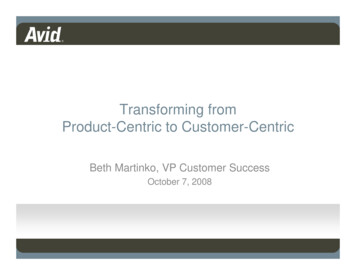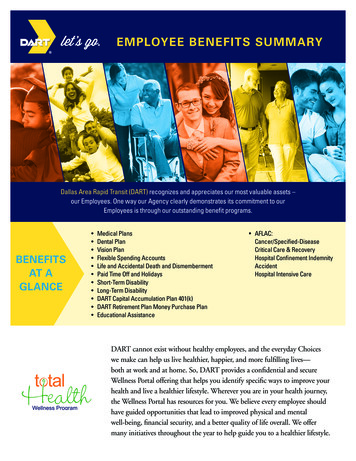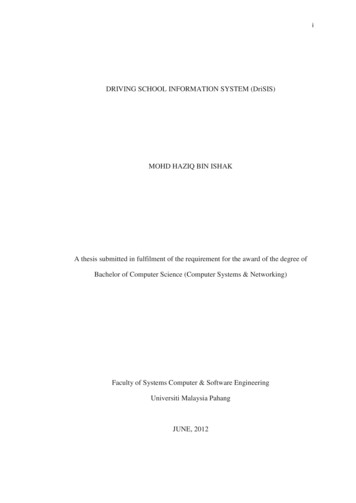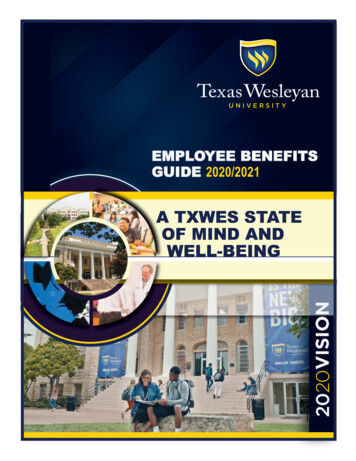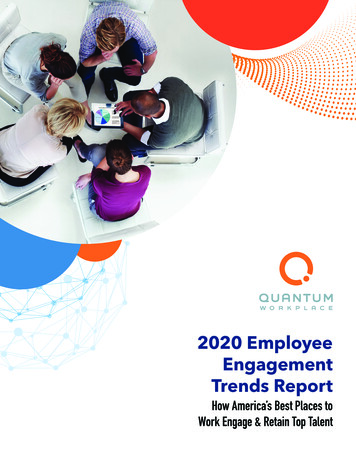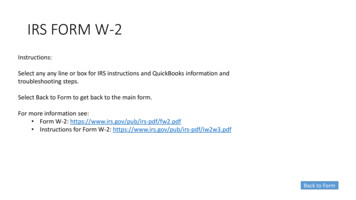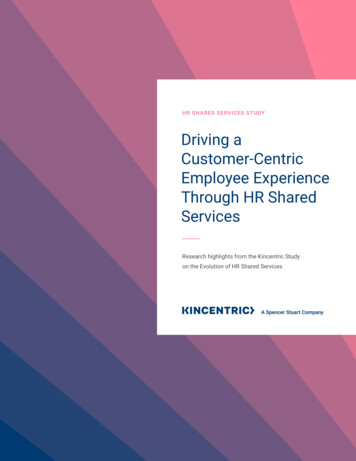
Transcription
HR SH ARED SERVICES STUDYDriving aCustomer-CentricEmployee ExperienceThrough HR SharedServicesResearch highlights from the Kincentric Studyon the Evolution of HR Shared Services
HR SH ARED SERVICES STUDYTable of ContentsExecutive Summary 3Business Priorities Driving Adoptionof HR Shared Services 4Expanding Scope of Services 7Deploying the Right Supporting Technology 11Choosing the Right Location 16Aligning HR Shared Services in the Organization 19Achievement of Objectives ThroughHR Shared Services 23Conclusion 26Survey Demographics 282Driving a Customer-Centric Employee Experience Through HR Shared Services
HR SH ARED SERVICES STUDYExecutive SummaryAs organizations set their sights on profitable growth, there has been a seismic shift inwhat executive leadership expects from the human resources (HR) function regardingbusiness strategy support. At the same time, employees increasingly expect HR todeliver a consumer-grade experience similar to what they receive from leading brands.As a result, HR leaders are doubling down on shared services to help them refocustheir resources and put greater emphasis on delivering enhanced customer serviceand better talent strategies, initiatives, and programs. Kincentrics’s 2017 HR SharedServices Study was conducted in order to gain a better understanding of the growth ofHR shared services in today’s complex business environment. Questions centered ontopics such as: Why is your organization considering a move to shared services?What scope of services will be delivered via this model?Are you bundling other business functions with HR?How will your employees access and interact with HR shared services?Key insights uncovered and discussed in more detail throughout the rest ofthe report include: Delivering a better customer experience—rather than cost reduction—is the maindriver behind implementing an HR shared services model.Organizations are placing greater trust in HR shared services to handle complexadministrative processes.Despite the growth in global business services, the majority of organizationscontinue to maintain HR shared services as a stand-alone function.Organizations are deploying shared services centers in multiple regions andlanguages to provide a more customer-centric experience.“.employees increasingly expect HR to delivera consumer-grade experience.”3Driving a Customer-Centric Employee Experience Through HR Shared Services
HR SH ARED SERVICES STUDYDRIVING A CUSTOMER - CENTRIC EMPLOYEEEXPERIENCE THROUGH HR SHARED SERVICESBusinessPriorities DrivingAdoption of HRShared Services4Driving a Customer-Centric Employee Experience Through HR Shared Services
HR SH ARED SERVICES STUDYBusiness Priorities DrivingAdoption of HR Shared ServicesRegardless of whether they are selling a product or a service, organizations relyon their employees to deliver a positive experience for their customers. Since theworkforce plays a pivotal role in driving the success of the company, it logically followsthat services should be delivered to employees in a similar fashion. Increasingly,organizations are recognizing the need to innovate and deliver enhanced service toboth their internal and external customers.HR is seeking to deliver a consumer-grade experience in every interaction throughoutthe employee life cycle. Yet many HR models are decentralized and siloed, leadingto problems with scale, integration, and lack of consistency in delivery, process, andsupporting infrastructure. These barriers hinder organizations in their effort to delivera frictionless experience. As a result, HR leaders often find themselves engaged inlow-value activities, preventing them from serving as strategic advisors and drivers ofgrowth and innovation.COMMON CHALLENGES WITH HR MODELSEmployee FrustrationFragmentation and SilosInability to Meet Business Needs Broken processes Multi-page job aids for basictasks Tactical verses holistic HRcustomer service Not knowing where to go forwhat Multiple systems that don’ttalk to one another Functional silos Lack of alignment withbusiness needs Inability to mobilize resources Lack of integration Misaligned HR leadership team Lack of understanding of whatstrategic HR means Program focus vs. outcomefocus Mismatch of capabilities Reactive vs. proactive Lack of meaningfulmeasurement5Driving a Customer-Centric Employee Experience Through HR Shared Services
HR SH ARED SERVICES STUDYCustomer Experience is Drivingthe Move to Shared ServicesIn order to reduce employee frustration, eliminatefragmentation, and free up time to focus on more strategicactivities, HR leaders are rethinking their HR service deliverymodels. As a result, HR leaders are turning to a sharedservices model. While cost reduction remains a key objectivebehind the deployment of shared services—cited by 71% ofrespondents as “very important”—it is eclipsed by the desireto improve delivery capabilities (90%), improve customersatisfaction (77%), and enable HR transformation (73%).OBJECTIVES DRIVING HR SHARED SERVICES DEPLOYMENTSVery ImportantSomewhat Important100%90%10%23%80%Not 6%73%71%46%65%20%10%23%19%0%6ImproveImproveEnable HRReduceAchieve ProcessScale forIntegrate uturefor PriorCapabilitiesSatisfactionDriving a Customer-Centric Employee Experience Through HR Shared ServicesMergers &Mergers &AcquisitionsAcquisitions
HR SH ARED SERVICES STUDYDRIVING A CUSTOMER - CENTRIC EMPLOYEEEXPERIENCE THROUGH HR SHARED SERVICESExpandingScopeof Services7Driving a Customer-Centric Employee Experience Through HR Shared Services
HR SH ARED SERVICES STUDYSupport for Complex TotalRewards Work Activitiesis on the RiseThe top processes in scope for total rewards are health andwelfare benefits (91%), leaves of absence (82%), and basepay services, such as managing merit and other base paychanges (78%). Notably, more than 40% of organizationssurveyed said they deliver highly complex HR transactions—including global relocation (53%), executive compensation(44%), and stock/equity plans (43%)—via a shared servicesmodel. This points to a promising trend toward greater trustin shared services’ ability to handle complex administrativeprocesses.PROCESSES IN SCOPE—TOTAL REWARDSIn ScopeNot In Scope91%H&W Benefits Admin82%LOA Admin18%78%Base Pay22%71%Savings/401K29%68%Bonus/Incentive Plans32%66%Pension AdminDomestic Relocation62%Disability Admin60%34%38%40%59%Inpat/Expat Admin41%57%Perquisite Admin43%53%Global Relocation47%44%Executive Plans56%43%Stock/Equity Plans0%89%20%57%40%Driving a Customer-Centric Employee Experience Through HR Shared Services60%80%100%
HR SH ARED SERVICES STUDYHRIS Support and HR Reportingand Analytics are IncreasinglySupported by Shared Serviceseffective case management technology to coordinate acrossbusiness support functions are finding that employees areable to get productive sooner.Routine transactions top the list of processes in scopefor personnel administration and compliance, with nearlyall respondents using a shared services model to deliveremployee life cycle processing (96%), employee personal datamaintenance (95%), and employment/salary verification (90%).A high percentage (84%) of companies are also employingshared services to handle human resources informationsystem (HRIS) support. This is likely being driven by thegrowth in SaaS human capital management (HCM) systemadoption, as traditional IT roles and alignment for HRISsystems shift into HR. Also notable is that three-quartersof the surveyed firms have HR reporting and analyticssupported by the shared services organization.A significant percentage (84%) of companies are employingshared services to handle new hire onboarding (coordinationof the entire onboarding process across support functionsfrom HR, to IT, to facilities, etc.). Many organizations strugglein this area—resulting in a poor new hire experience.Organizations that combine a shared services model withPROCESSES IN SCOPE—PERSONNEL ADMINISTRATION AND COMPLIANCEIn ScopeNot In ScopeEmployee Life Cycle Processing96%4%Employee Personal Data Management95%5%90%10%89%11%Employment/Salary VerificationEmployee Inquiry/Issue HandlingHRIS Support84%16%New Hire Onboarding84%16%79%Payroll Administration75%HR Reporting & Analytics25%71%Unemployment Comp/Insurance Admin29%64%Visa/Immigration Admin36%Employee /Labor Relations48%52%Staffing & Recruiting48%52%45%Workers Compensation (U.S.)0%921%20%Driving a Customer-Centric Employee Experience Through HR Shared Services55%40%60%80%100%
HR SH ARED SERVICES STUDYPerformance Managementand Onboarding Deliveredvia Shared Services“make or break” elements in this service grouping that aremost frequently delivered via shared services. The number ofemployers delivering employee relations (EEO, investigations,compliance, etc.) via a centralized shared services model issignificant at 58%, and remains high regardless of industryfor both unionized and non-unionized populations.As employers seek to shape the employee experience, theyare increasingly relying on HR shared services to supportperformance management process administration(78%) and offer and onboarding (67%), (which includespreparing the offer letter and performing pre-hire onboardingactivities). These two areas are both widely consideredPROCESSES IN SCOPE—WORKFORCE MANAGEMENT AND RELATIONSIn ScopeNot In Scope78%Performance Mgmt. Process Admin67%Offer & Onboarding33%64%Learning Administration36%62%Workforce Analytics38%58%Empl. Relations42%51%Sourcing & Recruiting49%42%Empl. Communications58%40%Assessment & Selection60%33%Workforce Planning67%31%Labor/Union Relations/Works Councils0%1022%69%20%Driving a Customer-Centric Employee Experience Through HR Shared Services40%60%80%100%
HR SH ARED SERVICES STUDYDRIVING A CUSTOMER - CENTRIC EMPLOYEEEXPERIENCE THROUGH HR SHARED SERVICESDeploying theRight SupportingTechnology11Driving a Customer-Centric Employee Experience Through HR Shared Services
HR SH ARED SERVICES STUDYSaaS/Cloud SolutionsContinue to ShowStrong AdoptionAs HRIS solutions continue to evolve in terms of bothtechnological innovations and specific offerings, it shouldcome as no surprise that SaaS/cloud solutions continueto show strong adoption. Of our respondents, 48% havedeployed a SaaS/cloud HCM system, while 42% maintain anon-premise system.10 48 42tWorkday accounts for the largest share of SaaS/cloud HCMdeployments, followed by SAP Success Factors EmployeeCentral and Ultimate Software UltiPro. When it comes to theon-premise solutions, there was a fairly even split betweenSAP HCM and Oracle products such as PeopleSoft andOracle HCM On-Premise.ADOPTION OF HCM TECHNOLOGY PLATFORMS42% On-Premise1210% Other48% SaaS/cloudDriving a Customer-Centric Employee Experience Through HR Shared Services
HR SH ARED SERVICES STUDYSpecialized Portals Noteworthy,Reliance on In-House PortalsRemains SignificantWhile specialized portals for delivering online HR content areused by nearly half of the respondents (47%), a significantportion (39%) still use in-house developed solutions. Thenumber of organizations that rely on such sub-optimal, inhouse developed employee portal platforms remains high,but we are encouraged by the growing trend toward the useof proprietary portal solutions and expect to see continuedinvestments in tools that deliver rich, easily searchable andpersonalized HR content.39 14 1346910tADOPTION OF HCM TECHNOLOGY PLATFORMS14% S AP Portal10% ServiceNow9% Outsourcing VendorProprietary Tool6% Oracle4% PeopleDoc3% Salesforce.com1% N eocase Software1348% SaaS/cloud10% OtherDriving a Customer-Centric Employee Experience Through HR Shared Services
HR SH ARED SERVICES STUDYSpecialized Case ManagementSoftware is GrowingSurvey results indicate a growing demand for full-functionHR-specific case management systems to effectively trackissue resolution and measure effectiveness of an HR sharedservices function. In fact, nearly three-quarters (72%) ofrespondents have deployed such a solution.25 12 16347818tOrganizations that have not implemented rich portalsand case management systems are more likely to reportthat they have failed to achieve the results they expectedfrom deploying HR shared services (see page 22 for moreon these results). This is a clear indication that in-housedeveloped applications cannot provide the same levelof functionality as leading case management solutions,resulting in difficulties in meeting delivery capability goalsand cost objectives.IMPLEMENTING CASE MANAGEMENT SOFTWARE18% SAP8% Outsourcing VendorProprietary Tool7% Oracle CRM4% Salesforce.com4% PeopleSoft Help Desk3% BMC3% Neocase Software14Driving a Customer-Centric Employee Experience Through HR Shared Services25% ServiceNow12% I n-House Developed(includes SharePoint)16% Other
HR SH ARED SERVICES STUDYChannels of CommunicationChanging with TechnologyAdvancementsNot long ago, employees had little choice in how they couldaccess HR services. An employee could walk into the localHR office or contact HR shared services via an email addressand phone number, often with a rudimentary phone menu.their developmental and adoption infancy. While they arebecoming increasingly common in areas such as financeand retail, their utilization in HR is still low, at just 6% and 8%,respectively.Fast-forward to today and we see the available channelsof communication are evolving to keep pace with howemployees prefer to access information. While call centertelephony remains a key channel (81%), nearly 40% ofrespondents now interact with employees via onlinechat, which was considered merely an emerging channeljust a few years ago. Other technologies such as virtualassistants and robotic process automation are still inFurther, while the need to reach employees “where theylive” is often touted, mobile deployment remains quite low.Just 34% of respondents provide mobile access to theknowledge base, and less than 20% provide access via amobile application to the other service channels. However,as organizations continue to invest in offering servicesthat meet customer needs and preferences, this is likely tochange.ACCESSING HR SERVICES ACROSS MULTIPLE CHANNELSUtilizedNot UtilizedDon’t Know88%Knowledge Base85%Case Management1%60%8%81%6%0%11%86%20%Driving a Customer-Centric Employee Experience Through HR Shared Services2%35%39%Online Chat1528%65%Document Management1%19%70%Workflow AutomationArtificial IntelligenceVirtual Assistance14%81%Call Center TelephonyRobotic Process Automation12%40%6%60%80%100%
HR SH ARED SERVICES STUDYDRIVING A CUSTOMER - CENTRIC EMPLOYEEEXPERIENCE THROUGH HR SHARED SERVICESChoosing theRight Location16Driving a Customer-Centric Employee Experience Through HR Shared Services
HR SH ARED SERVICES STUDYTalent Availability is the TopFactor in Selection of SharedServices LocationIn a related finding, a significant number of organizations(43%) have established multiple regional centers. This likelyreflects the desire to provide regionally and locally adaptedservices to employees across the globe during normaloperating hours, thus increasing customer satisfaction.As companies strive to identify the most suitable locationsfor their shared services centers, they overwhelmingly citetalent and skills availability (64%) and proximity to employeepopulations (50%) as key factors—outpacing labor costs,which are considered key by just 45% of respondents.FACTORS INFLUENCING THE CHOICE OF HR SHARED SERVICES LOCATIONSKey FactorMinor FactorNot a Factor64%Talent /skills availability19%50%Proximity to employee populationsLabor costs45%Location of company employees tojoin HR Shared services management45%Co-location with other companyshared services or operations28%0%31%Centers16% Single Centerwith Global Scope4% Single RegionalCenter26% Single In-CountryCenter43 26 41611t17Driving a Customer-Centric Employee Experience Through HR Shared Services26%28%40%GEOGRAPHIC DEPLOYMENT OF HR SHARED SERVICES11% Multiple In-Country19%29%28%20%17%12% M ultiple RegionalCenters27%44%60%80%100%
HR SH ARED SERVICES STUDYOrganizations Serve Employeesin Native LanguageDelivering customer-centric services requires a thoughtfulapproach that facilitates ease of communication foremployees and managers. Accordingly, organizations shouldstrongly consider providing native language support forboth voice service and online content. Survey respondentsreport multiple languages supported by their service centers,with English, French, Spanish, Chinese (most frequentlyMandarin), and German the most commonly supported.English is the only language almost solely supportedthrough in-house agents (vs. third-party translation services),because many organizations have designated English astheir language of business. Additionally, approximately 50%of organizations support Spanish and French via in-houseagents.SERVICE CENTER LANGUAGE SUPPORTLanguages Available in HR Call Center(s)100%Language Not Offered3%80%60%40%Languages Available in Online Content seGerman0%EnglishSpanishFrenchIN-HOUSE LANGUAGE SUPPORTIn-House Language Services100%Third-Party Translation Services3%80%47%50%3%3%60%40%No hineseGerman0%English18Driving a Customer-Centric Employee Experience Through HR Shared Services
HR SH ARED SERVICES STUDYDRIVING A CUSTOMER - CENTRIC EMPLOYEEEXPERIENCE THROUGH HR SHARED SERVICESAligningHR SharedServices in theOrganization19Driving a Customer-Centric Employee Experience Through HR Shared Services
HR SH ARED SERVICES STUDYShared Services Aligns to HROrganizations vs. a Global BusinessServices ModelMost organizations using HR shared services are optingto operate it as a stand-alone function aligned to the HRorganization rather than as a part of a global businessservices (GBS) organization (84% vs. 16%), which typicallyhouses a number of supporting functions (finance, IT,procurement, etc.) under one umbrella. Regional andsingle-country organizations are slightly more likely to alignHR shared services under a GBS model than companieswith multi-country operations (29% vs. 14%). This is mostlikely a function of complexity and scale. As the scale andcomplexity of HR delivery increase, there appears to be apropensity to leave shared services in a stand-alone model,acknowledging the need for a specialized approach withstrong local and regional subject matter expertise.16 84 t29 71 t14 86 tH R S hared S ervices A lignment—G B S or S tandalone84% Stand-AloneFunctionUnder HR16% Multi-FunctionGBSC ompanies W ith O perations in O nly O ne C ountry71% Stand-AloneFunctionUnder HR29% Multi-FunctionGBSC ompanies W ith O perations in M ore T han O ne C ountry86% Stand-AloneFunctionUnder HR20Driving a Customer-Centric Employee Experience Through HR Shared Services14% Multi-FunctionGBS
HR SH ARED SERVICES STUDYReasons for Movingto a GBS ModelOrganizations that have moved to a GBS modeloverwhelmingly cite cost reduction (62%) as a major factorin their decision to move to a multi-function model for HRshared services delivery. Other commonly cited reasonsinclude the desire to leverage technology investments acrossservice functions (54%), leverage management acrossservice functions (46%), and leverage staff across servicefunctions (46%).R eason for M ove to G B S M odelMajor Factor100%90%80%70%Minor Factor7%Not a 50%40%30%62%20%54%38%10%0%Achieve costLeverageLeverageLeverage across serviceprocessfacilitiesinvestmentsacross servicefunctionsacross servicesfunctionsfunctions21Driving a Customer-Centric Employee Experience Through HR Shared Servicesintegrationinvestmentsacross serviceacross servicefunctionsfunctions
HR SH ARED SERVICES STUDYServices BundledTogether in GBSAmong those companies employing a GBS model,accounting (77%) and procurement (77%) are mostcommonly paired with HR, followed by IT support (69%),legal/compliance support (46%), and facilities support (46%).S ervices B undled T ogether in G B SSame Shared Services Organization as HRNot Same Shared Services Organization as ortIT SupportDriving a Customer-Centric Employee Experience Through HR Shared Services
HR SH ARED SERVICES STUDYDRIVING A CUSTOMER - CENTRIC EMPLOYEEEXPERIENCE THROUGH HR SHARED SERVICESAchievementof ObjectivesThrough HRShared Services23Driving a Customer-Centric Employee Experience Through HR Shared Services
HR SH ARED SERVICES STUDYCost Reductions, HR Transformation andDelivery Capabilities Achieved ThroughHR Shared ServicesOrganizations that have deployed HR shared servicesreported strong success in achieving many of their statedgoals. When it comes to their top objective of improvingdelivery capabilities, respondents say they are eithermeeting (61%) or exceeding (10%) expectations. Similarly,they reported either meeting (62%) or exceeding (5%)expectations in enabling HR transformation. While reductionof cost was not the top stated objective, organizations areracking up gains in that area as well, with 64% reportingexpectations met and 9% reporting expectations exceeded.Organizations fell short of achieving their objectives in twokey areas: improving customer satisfaction and achievingprocess harmonization. When we look deeper at the data,a few findings emerge that could explain the apparentdisconnect in improving customer satisfaction. Of those thatresponded, nearly half reported using something other than aleading HR portal solution and case management tool.We continue to emphasize with our clients that they mustmake these critical investments to support a customercentric experience when deploying shared services.Similarly, in relation to the struggle to achieve processharmonization, we observed an even split in organizationsthat have deployed an on-premise HCM system vs. thosethat have deployed a SaaS HCM platform. We are seeingorganizations that have recently implemented new HCMsystems struggle to improve service delivery and customersatisfaction because they opted for a “lift-and-shift”approach to processes and supporting roles. As a result,these organizations are missing the opportunity to step backand determine how HR processes can be better configuredfor a shared services model. Therefore, while designing newshared services processes, it is crucial to understand thetechnology that is being implemented and how the customerwill interact with it in the organization’s service deliverymodel. Ignoring this can lead to broken processes andcustomer frustration.O bjective A chievement—H R S hared S ervicesCannot Say at This Point in Time100%9%5%64%62%Falling Short of Expectations10%Meeting tSupportIT SupportDriving a Customer-Centric Employee Experience Through HR Shared ServicesSurpassing Expectations
HR SH ARED SERVICES STUDYFuture Plans for HR SharedServices in a GBS modelOf those in a GBS model, only a small number respondedto our question about achieving expected results. Theyreported the most success in achieving cost savings andleveraging staff and technology. However, over 50% didn’trespond to this question, which could indicate a lack ofmeasurement or knowledge of the actual achievement ofthose objectives.9 14 163015tLooking ahead, there appears to be no strong trend towardmoving to a multi-function GBS model for HR sharedservices. While 39% are thinking about moving to a GBSmodel, just 9% have a specific plan for doing so. We believethat organizations should prioritize customer-centric deliveryover cost reduction when changing their HR shared servicesdelivery model.F uture P lans for H R S hared S ervices A lignment—G B S or S tandalone16% No response15% I don’t know30% No25Driving a Customer-Centric Employee Experience Through HR Shared Services9% Y es, and specificplans exist14% Y es, but no specificplans exist16% O nly exploringpossibilities
HR SH ARED SERVICES STUDYConclusionSavvy leaders understand that patents, property, and products will take them only sofar in achieving their growth goals. It’s their people who are the true determinants oforganizations’ success—or failure. Increasingly, these critically important people arecoming to expect an employment experience that matches what they encounter wheninteracting as consumers in their lives outside work.At the same time, leading organizations recognize the need to transform HR in order tofocus their resources on the most value-added activities (e.g., attracting and retainingtop talent and developing effective leaders). Introducing a leading practice HR servicedelivery model supports these objectives.K incentric B est P ractice M odel for H RCenter of Expertise (COEs) 26Understand business needs and produce competitive HR solutionsMaintain awareness of market trends, best practices and leading edge programsTailor HR, rewards and talent management programs, policies, processes, and practicesDriving a Customer-Centric Employee Experience Through HR Shared Services
HR SH ARED SERVICES STUDYConclusion (Continued)HR Business Partners Partner with business leaders to develop and drive human capital strategiesProvide ongoing strategic advisory support to leadersTranslate business needs into HR requirements and evaluate services delivered tothe businessModel-Specific HR Roles Depending on the need, provide “delivery” of HR including face to- face support foremployees and managersDepending on the need, provide local, high-touch services where an on-sitepresence is necessaryHR Operations Provide employee-facing support and administration of HR programs andprocesses via HR shared services teamsRationalize and manage HRIS infrastructureIntegrate and optimize processesDrive efficiencies through standardization of transaction processingWe see the adoption of HR shared services as a clear strategic imperative that willcontinue to play a critical role in enabling and driving transformation.Delivering consumer-grade services and tools to employees not only reducesfrustration, but also improves employee engagement. Moreover, effective deliveryof shared services has the potential to enhance the attraction and retention of toptalent by allowing HR to focus on talent and leadership development, which ultimatelycreates an environment and culture where employees are fully engaged to do theirbest work.27Driving a Customer-Centric Employee Experience Through HR Shared Services
HR SH ARED SERVICES STUDYSurvey DemographicsStages of ImplementationOf the 80 companies that responded to the survey, nearly three-quarters (70% of allrespondents) have rolled out shared services, with 30% reporting their solutions arefully deployed and mature and 40% saying theirs are fully deployed, but not yet mature.The other 30% of respondents indicated that they are still rolling out their solutions.Countries of OperationThe vast majority of those surveyed (80% of all respondents) report having operationsin more than one country, with the following distribution:18%18%2-10 Countries11-30 Countries35%9%31-100 CountriesMore than 100 CountriesGeographic DistributionOur survey respondents come from a diverse group of organizations with employeesin all global regions and industries. Half of all represented workers are located in NorthAmerica, while 21% are in Asia, 18% in Europe, 5% in South America, 3% in Australia,and 2% in Africa.28Driving a Customer-Centric Employee Experience Through HR Shared Services
HR SH ARED SERVICES STUDYSurvey Demographics (Continued)R evenueN umber of E mployeesParticipants from the entire spectrum of revenue sizes tookOrganizations of all sizes participated in this study withpart in this study. Revenue amounts ranged from underparticipants evenly distributed among the different 1 Billion (12%) to more than 100 Billion (6%)employee count categories1% Other6% Over 100B12 33 141061t 11 22 201381016t12% Lessthan 1B10% 50B– 100B10% 20B– 50B10% 60,000–100,000I h nal Services9%Mining, Oil, and umer Products4%Retail3%Technology Hardware2%Education1%29Driving a Customer-Centric Employee Experience Through HR Shared Services22% 5,000–10,0008% 40,000–60,00013% 20,000–40,00014% 5B– 10Bthan 5,00016% Greaterthan 100,00033% 1B– 5B14% 10B– 20B11% LessRespondents came from every major industry withManufacturing being the most highly represented industryat 25%, followed by Finance/Insurance (16%) andHealth Care (12%).20% 10,000–20,000
ContactsTom FriedrichPartnerHR & Talent Advisory U.S.tom.friedrich@kincentric.comMichael MartinPartnerHR & Talent Advisory Global Practice Leadermichael.martin@kincentric.comMatt RoseDirectorHR & Talent Advisory U.S.matt.rose@aonhewitt.comKincentricJennifer G. WichPartnerHR & Talent Advisory U.S.jennifer.wich@kincentric.comContact us to talk about how we can help.About KincentricKincentric, a Spencer Stuart company, approacheshuman capital differently – we help you identifywhat drives your people, so they can drive yourbusiness. Our decades of expertise in cultureand engagement, leadership assessment anddevelopment, and HR and talent advisory servicesenable us to help organizations change fromthe inside. Our global network,
driver behind implementing an HR shared services model. Organizations are placing greater trust in HR shared services to handle complex administrative processes. Despite the growth in global business services, the majority of organizations continue to maintain HR shared services as a stand-alone function.
